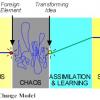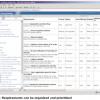 |
You Can't Fight Change We can probably agree that, for the most part, change is good. But it is also disruptive, and can even create chaos. In this column, Becky Winant explains a familiar model of the change process, and offers some ways to acknowledge and cope with change in the workplace.
|
|
|
|
Achieving Software Quality Through Test Automation Process Integration With increasing demands for high-quality software applications in shorter development cycles, it's clear that teams need to go beyond simply running tests at the end of their development cycle. Instead, teams must approach development with quality as their primary objective. Brian Bryson shows you how to integrate automated testing tools with best practices to implement an effective quality assurance process from the beginning (and throughout) the development lifecycle.
|
Brian Bryson, Rational Software Corporation
|
 |
A Look at Rational's RequisitePro Creating requirements involves tracking and documenting all of the criteria for a system's success. A requirements management tool, such as IBM Rational's RequisitePro, can support this effort. While the tool won't verify that the requirements are consistent, correct, complete, relevant, coherent, and testable, it can help manage the task more efficiently by allowing you to document, track, and maintain the requirements in an automated fashion.
|
|
|
|
Ellen Gottesdiener on Requirements Exploration and Modeling Translating customer requests into software requires exploration, learning, and discovery. As such, this Reference Point lists resources you can use to learn more about requirements exploration and modeling. Ellen Gottesdiener—a recognized authority on software requirements—provides her top recommendations for books, journals, and online resources on the subject.
|
|
|
|
Use Cases, Ten Years Later Use cases have experienced a long and sometimes rocky history. Look back on the evolution of use cases to better understand how to use them today.
|
|
|
|
Gathering Users for Great Requirements If you buy a hammer, you are not considered a master carpenter automatically. The same holds true for tool knowledge alone solving requirements problems. Kelley Schmidt shares the biggest lesson she learned on a project: commercial process and tools alone cannot lead to project success.
|
|
|
|
Testing Your Software's Requirements Many testing organizations focus primarily on software executable code, but that's not the only thing you can test. For instance, did you ever consider testing your software requirements? When you test only code, you face some big disadvantages, not to mention that design defects often aren't even fixable because they demand too much effort, too late in the release cycle. In fact, it's difficult to even report some requirements defects since the developers have already committed to the design strategy. But if you test your requirements early in the game, you can discover defects before they're cast into designs and code, consequently saving your organization potentially huge rework costs.
|
Brian Lawrence, Coyote Valley Software
|
|
|
Software Documentation Superstitions Do you need credible evidence that disciplined document reviews (a.k.a. inspections) can keep total project costs down while helping you meet the schedule and improve quality? The project documentation we actually need should meet predetermined quality criteria, but organizations are often superstitious about writing this documentation-and they let their superstitions inhibit their efforts. This presentation dispels the superstitions and shows you how reinforcements for improving the quality of your software project documentation-such as requirements, design, and test plans/procedures-can occur through disciplined document reviews.
|
Gregory Daich, Software Technology Support Center
|
|
|
What's That Supposed to Do? The Archeology of Legacy Systems In testing utopia, all software products submitted for testing have thorough and comprehensive documentation describing how every program function should work. On planet Earth, however, test engineers usually have to make do under less-than-ideal circumstances. It's not uncommon for test engineers to be asked to verify the functionality of a critical legacy system which has no documented requirements whatsoever. While there are many reasons this can happen, the result is the same: You assume the role of an archeologist sifting through the layers of clues to reconstruct the specifications. Patricia Ensworth gives you instructions and tools so you'll be ready to roll up your sleeves and dig.
|
Patricia Ensworth, Moody's Investors Service
|
|
|
The Road to UML is Paved with Good Intentions A picture is worth a thousand words. Does that mean that a model is worth a thousand requirements? A thousand test cases? Not exactly, but a model will tremendously aid in the development of requirements and test cases, and help facilitate inter-team communication of requirements and test cases; at least, that's always the intent. One way to help ensure that these good intentions come to fruition is to test the diagrams that the model is composed of, for 4C compliance-completeness, correctness, consistency, and clarity. There are different languages for producing models, but this presentation focuses on the Unified Modeling Language (UML), and methods of testing models that are created with UML.
|
Dion Johnson, Pointe Technology Group
|

